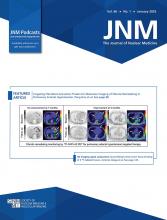Meningiomas are the most common primary adult intracranial tumors and are characterized by a highly variable clinical course. Although most meningiomas can be cured by surgical resection, 20%–25% of meningiomas recur and require additional therapies such as repeated resection, radiotherapy, or experimental pharmacotherapies (1). Most meningiomas show high expression of somatostatin receptors (SSTRs), more specifically SSTR2 (2). Therefore, the application of radiolabeled SSTR ligands is widely considered to have high potential for improved meningioma management. However, to date, guidelines for standardization of SSTR-targeted PET imaging and radiopharmaceutical therapy in routine practice and clinical trials have not been available. Recently, the European Association of Nuclear Medicine (EANM), the Society of Nuclear Medicine and Molecular Imaging (SNMMI), the European Association of Neuro-Oncology (EANO), and the PET task force of the Response Assessment in Neuro-Oncology Working Group (RANO) have jointly developed practice guidelines and procedure standards for SSTR-directed PET imaging and radionuclide treatment of meningiomas (3).
For SSTR-targeted PET imaging of meningiomas, 68Ga-labeled tracers based on modifications of the SSTR agonist octreotide, such as [68Ga]Ga-DOTATOC, [68Ga]Ga-DOTATATE, and [68Ga]Ga-DOTANOC, are most commonly used. In the United States, [68Ga]Ga-DOTATATE and [64Cu]Cu-DOTATATE are readily available, with a variable but overall increasing degree of insurance coverage, and the cost-effectiveness of [68Ga]Ga-DOTATATE PET/MRI in the management of meningiomas has recently been demonstrated in a U.S. health care setting (4). SSTR-targeted PET imaging of meningiomas is increasingly considered in a variety of clinical scenarios, including differential diagnosis, delineation of tumor extent, surgical and radiotherapy planning, differentiation of tumor recurrence from treatment-related changes, and prognostication (1,5,6). SSTR-targeted PET has also been proposed for disease monitoring of meningiomas (7), and standardized criteria for PET-based response assessment similar to those recently established for gliomas (8) are scheduled for development by the RANO group to facilitate applications in patient management and clinical trials.
Concerning therapeutic use of radiopharmaceuticals in meningiomas, the current evidence is based on small case series and small and uncontrolled prospective trials only (9). A recent interim analysis of an ongoing single-arm phase II trial reported that the predefined progression-free survival rate at the 6-mo threshold was met; furthermore, [68Ga]Ga-DOTATATE PET was highlighted as a potentially useful imaging biomarker to assess response to radiopharmaceutical therapy (10). Importantly, the first randomized trial evaluating [177Lu]Lu-DOTATATE for recurrent meningioma (LUMEN-1; NCT06326190) is scheduled to start patient accrual in the first quarter of 2025 and will, for the first time to our knowledge, provide controlled data on this radiopharmaceutical therapy for meningiomas.
Overall, these developments have led to an increase in the use of SSTR-directed PET imaging and therapy in routine clinical practice and its integration into clinical trials. The new EANM/EANO/RANO/SNMMI guidelines provide a comprehensive reference with expert recommendations for the indication, acquisition protocol, interpretation, and reporting of SSTR-targeted PET imaging, as well as procedure standards for SSTR-targeted radiopharmaceutical therapy for meningiomas. The guidelines provide detailed information on a wide range of topics, including equipment and tracer types, patient procedures, criteria for image analysis, dosing and administration regimens of radiopharmaceuticals, recommended comedications, dosimetry, monitoring and follow-up schedules, side effect prevention and management, and quality control measures. Importantly, the author group representing EANM, EANO, RANO, and SNMMI also stresses the need for adequately designed and controlled prospective multicenter trials for effective translation of SSTR-directed PET imaging, as well as radiopharmaceutical therapy of meningiomas, into the daily clinical practice of neurooncology. In the United States, these guidelines will further facilitate health insurance reimbursement for SSTR-targeted PET in meningioma, thereby increasing patient access to care and improving clinical outcomes. These guidelines further pave the way for future efforts toward insurance reimbursement of SSTR-targeted radiopharmaceutical therapy. Globally, this first edition of the guidelines and procedure standards will enable harmonization and standardization and is therefore an important contribution toward evidence-based and safe application of SSTR-targeted PET imaging and radiopharmaceutical therapy in patients with meningioma around the world.
DISCLOSURE
Nathalie Albert has received honoraria for consultation or advisory board participation from Novartis, Advanced Accelerator Applications, Servier, and Telix Pharmaceuticals; honoraria for lectures from OncLive; and research funding from Novocure. Jana Ivanidze is principal investigator on investigator-initiated clinical trials from Novartis, GE HealthCare, and Curium Pharma (funds paid to the institution). Matthias Preusser has received honoraria for lectures, consultation, or advisory board participation from the following for-profit companies: Bayer, Bristol-Myers Squibb, Novartis, Gerson Lehrman Group (GLG), CMC Contrast, GlaxoSmithKline, Mundipharma, Roche, BMJ Journals, MedMedia, AstraZeneca, AbbVie, Lilly, Medahead, Daiichi Sankyo, Sanofi, Merck Sharp & Dome, Tocagen, Adastra, Gan & Lee Pharmaceuticals, Janssen, Servier, Miltenyi, Boehringer Ingelheim, Telix, Medscape, and OncLive. Norbert Galldiks received honoraria for lectures from Blue Earth Diagnostics and for advisory board participation from Telix Pharmaceuticals. No other potential conflict of interest relevant to this article was reported.
Footnotes
Published online Oct. 10, 2024.
- © 2025 by the Society of Nuclear Medicine and Molecular Imaging.
REFERENCES
- Received for publication June 26, 2024.
- Accepted for publication September 9, 2024.







